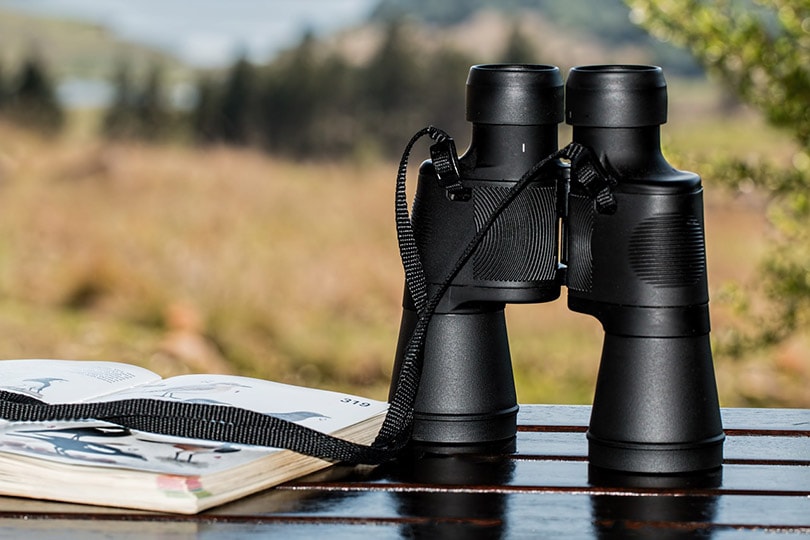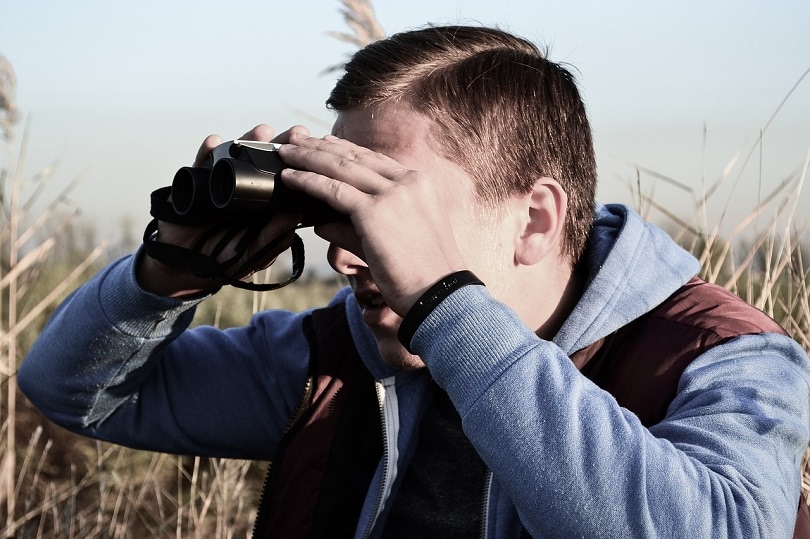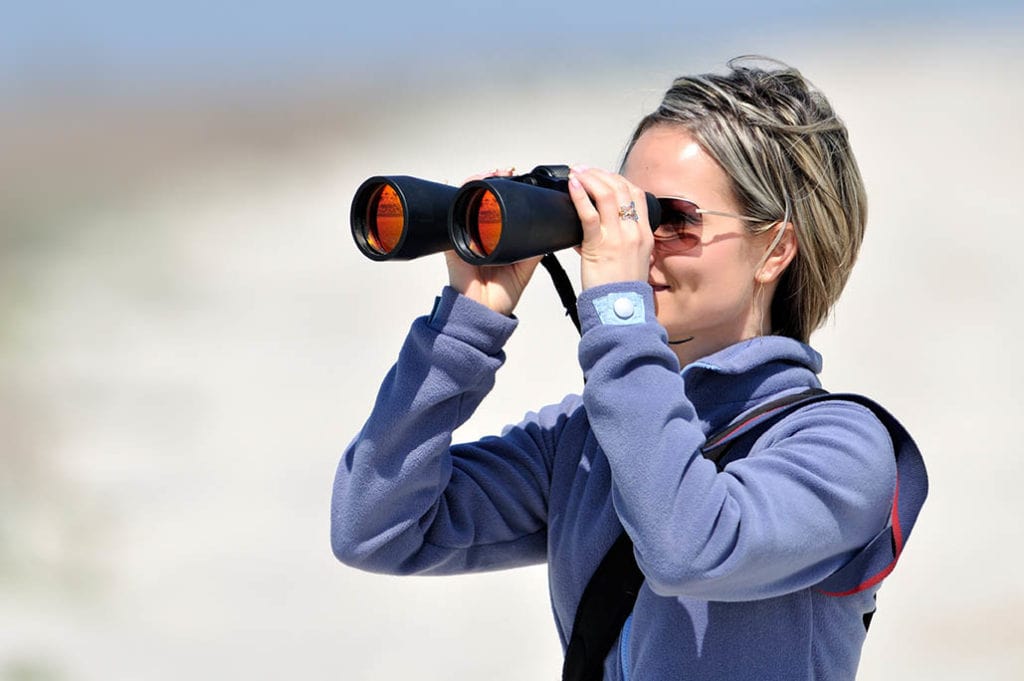How to Choose Binoculars for Bird Watching: 10 Expert Tips
Last Updated on

Binoculars are the main accessory for bird watching. But choosing the right one can be quite daunting considering the large number of options and types.
Below, we discuss top tips for choosing the right binoculars. Keep reading to learn about the features you must consider when binocular shopping.

The 10 Tips on How to Choose Binoculars for Bird Watching
1. Use a Three-Point Selection Criteria
Nowadays, there are hundreds of binoculars, each with the latest features. So, how do you pick the one that meets your needs? Here are three pointers to keep in mind.

- Budget: How much can you spend on binoculars? You can find a good pair for anywhere between $100 and $150. But the high-end ones can cost thousands of dollars. If you’re a hobbyist, a low-end binocular should suffice. But if you bird watch for research or photography, you may need to invest in a high-end binocular.
- Conditions: In which conditions will you use the binoculars? Will you use them during the day or at night? What is the weather like? All these factors will impact your purchase decisions.
- Comfort: You have to hold the binoculars for prolonged periods. So, they must be comfortable to hold and use. They should also not strain your eyes or be a burden if you wear glasses.
2. Consider the Price Points
It shouldn’t come as a surprise that you get what you pay for. The price points for binoculars fall into three categories: starter, intermediate, and expert.
Introductory models fall in the starter range and cost $100 to $150. These binoculars mostly have rubber body armor. They are also fog-proof and waterproof.
If you need more image clarity and brightness, opt for mid-level binoculars. They cost $150 to $350 and come with a decent warranty. Most of these binoculars are lightweight, easy to hold, and multi-coated.
The expert-level options cost $350 and above. In this range, you can expect to find premium features like water-repellent coating, ED glass, and high-end optics.
The key to setting a budget for binocular shopping is to determine the following:
- The frequency of use
- Required features
- Type of bird watching
Start and mid-level binoculars are suitable for most bird watchers. Only pay above $350 if you prefer the extra bells and tassels or need to bird watch for professional reasons.
3. Choose the Right Body Type
Binoculars come in two main body types: roof prisms and Porro prisms. Most high-end models are roof prisms due to their aesthetic appeal. Porro-prism binoculars have an angled body and a stepped shape. Meanwhile, roof-prism binoculars have a straight-through shape. They are also lighter and more comfortable. Since they have an internal focus, they are protected from weather elements.
Roof-prism binoculars also come with waterproof bodies. If you are birdwatching in harsh weather, these binoculars are the right choice. Since their lenses are coated, you’ll get sufficient light transmission even in rainy conditions.
If you plan to bird watch in bright conditions, you can use miniature compact binoculars too. They are lightweight, so you can hold them comfortably for long periods.
The downside to miniature models is their reduced field of view and light-gathering ability. But if that’s not an issue, they’re better than their larger counterparts.

4. Account for Your Disability
If you have a physical disability, the right binocular will depend on your personal preference and the type of disability. It’s best to try different models and decide which is most comfortable.
If you use low-magnification binoculars, they will need little refocusing. They are also steadier, which makes them easy to hold. Meanwhile, stabilizing binoculars are heavy and may cause fatigue.
You can also opt for electronic binoculars with a tilted head and sound amplification. Or talk to a specialist optical supplier to find personalized solutions.
5. Choose the Right Magnification
The best magnification for bird watching is 8x or 10x. Any weaker, and you’ll have trouble locating and tracking birds. Anything higher will make it difficult for you to get a steady view if you don’t have a tripod.
If you watch birds in open stretches or open countries, choose binoculars with 10x magnification. But if you stay in the woodlands or watch birds from close quarters, 8x should be enough.
When it comes to magnification, bigger is not always better. Binoculars with high magnification are more prone to movement. They are harder to stabilize, giving you a shaky view.
- More stability
- Wider field of view
- Brighter image
- Darker images
- Narrows depth of field
- Less stability
Since binoculars with high magnifications create a darker image, they’re not good for low-light conditions, such as evening bird watching.

6. Look for Glasses-Friendly Features
People who wear glasses should buy binoculars with sufficient eye relief. Here are two features that allow this:
- Twist-Down Eye Cups: A twist-down eye cup can be extended or retracted. It helps to bring the eyepiece of the binocular closer or further away from your face. Look for binoculars with silicon eye cups that can be twisted outward to inward.
- Removable Eye Cups: Some binoculars also have removable eye cups. Removing these can help you see through the binoculars without lifting your glasses away from your eyes.
Even with these features, using binoculars may be uncomfortable for some people, especially those who wear bulky glasses frames. Wearing contact lenses during bird watching might be a good alternative for such individuals.
7. Consider the Coatings
Binoculars may be fully, partially, or multi-coated. Here are the common types:
- Coated: These binoculars have at least one coating on the lens. Magnesium fluorite is the material commonly used in the coating.
- Fully Coated: In these binoculars, there’s a coating on all air-to-glass surfaces.
- Multi-Coated: These binoculars have multiple coatings on lens surfaces.
- Fully Multi-Coated: They have multiple coatings on all air-to-glass surfaces.
Besides these basic coating types, you should also know about specialized options. For example, many roof-style binoculars have dielectric high-reflective multilayer prism coating. These binoculars have excellent light reflectance and show brighter images.
Another type is the phase correction coating. It is also present on roof-style binoculars in the high-end price range. Phase correction can help reduce chromatic aberration and enhance sharpness.

8. Don’t Buy Too Big or Too Small
If the binoculars are too big, they will take up more space in your bag. They will also be heavier and uncomfortable to carry for long periods.
Meanwhile, binoculars that are too compact will have a poor field of view. They may also lack features like waterproof bodies and rubber armor. Also, you won’t be able to use them while wearing glasses.
Choose the mid-ground when buying binoculars—not too big and not too small. A mid-sized binocular will be easy to carry and have the most features you need.
9. Buy From Reputable Brands
It’s important to purchase binoculars from reputable brands to get the best value for money. Some good options include:
- Canon
- Nikon
- Celestron
- Vixen
You can also find second-hand options on online marketplaces. But again, buy second-hand binoculars from top brands since they are long-lasting and durable. You should also ensure all features, such as magnification and coatings, are in working condition before buying.

10. Try Them Out
Saving the best tip for last, you should try some binoculars before choosing your final pair. Many retailers let you try multiple options with no pressure to buy. You can also talk to the in-store professionals who can help you in the selection process.
If you want to buy binoculars online, read customer reviews on the company’s website and third-party sites. You can find detailed reviews by customers on Amazon. The product pages also have Q&A sections where you can find the answers to most of your queries.
Where to Buy Binoculars?
There are three main places you can buy binoculars from:
- Physical Retailers: Best Buy, Walmart, and REI are some retailers that sell binoculars. They also have in-store assistants to help you make the right choice.
- Online Retailers: Amazon and Binoculars.com are the top places to buy binoculars. You can also shop from Walmart’s online store.
- Marketplaces: Facebook Marketplace, eBay, and Craigslist are the right places to find second-hand binoculars. Avoid buying from sketchy sellers, especially if the price seems too good to be true. Watch a product video before you meet the seller so that you know which features to look for when testing the binoculars.
Other options include getting a pair from your local astronomy club or borrowing from friends. Some national parks may also have visitor’s centers or shops where you can purchase binoculars.

Conclusion
Buying the best binoculars for bird watching can be tricky if you don’t know what to look for. Per the expert tips in this guide, you should consider your budget, bird-watching conditions, and comfort level.
The best options are binoculars with 8x to 10x magnification, 42–50mm objective lens diameter, and fully multi-coated lenses. Make sure you buy from reputable sellers, online or in-store.
Featured Image Credit: HTWE, Shutterstock
About the Author Jeff Weishaupt
Jeff is a tech professional by day, writer, and amateur photographer by night. He's had the privilege of leading software teams for startups to the Fortune 100 over the past two decades. He currently works in the data privacy space. Jeff's amateur photography interests started in 2008 when he got his first DSLR camera, the Canon Rebel. Since then, he's taken tens of thousands of photos. His favorite handheld camera these days is his Google Pixel 6 XL. He loves taking photos of nature and his kids. In 2016, he bought his first drone, the Mavic Pro. Taking photos from the air is an amazing perspective, and he loves to take his drone while traveling.
Related Articles:
How to Collimate Binoculars: 9 Expert Tips
How to Clean a Rifle Scope: 8 Expert Tips
Can You Use Binoculars to Look At Stars? How to Choose the Right Pair
Binocular Magnification Chart: Numbers & Distances Compared
What Is the Best Binocular Magnification for Hunting? Optical Features Explained
When Were Binoculars Invented? History, Today & Future
What Does 20X50 Mean on Binoculars? Our Helpful Guide
10 Best Binoculars in Canada of 2024: Reviews & Top Picks
